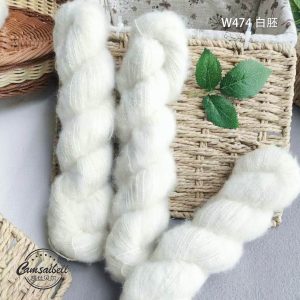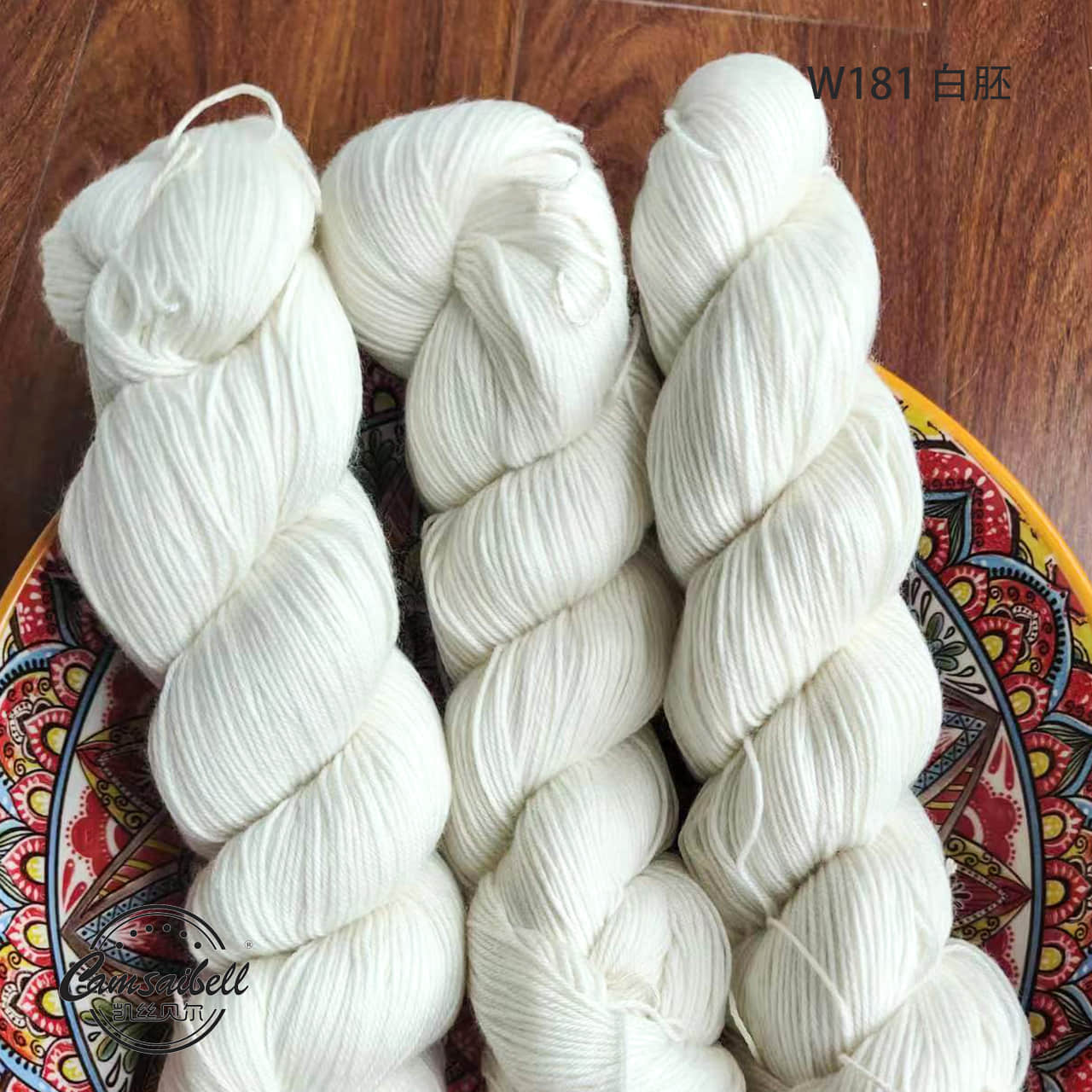Cashmere yarn is very common in the textile market and is often used as the main material for clothes, hats, scarves and other clothing. Compared with other materials, it is softer and more comfortable, and the yarn is also finer, so it is also used to produce baby clothes, which shows how comfortable it is. Next, we will analyze the uniqueness of cashmere yarn in detail.
What Is Cashmere Yarn
Cashmere yarn is a high-end natural yarn spun from the fine hair on the bottom of the goat’s abdomen. It is known for its extreme softness, lightness and warmth retention. Compared with ordinary wool yarn, cashmere yarn is more delicate and its diameter is usually between 14-19 microns. It is one of the most luxurious types of wool fabrics. Because of its rare raw materials and complex processing, it has always been regarded as a symbol of high-end textiles in the global market.

Where Does Cashmere Yarn Come From
Cashmere yarn is mainly produced from goats in cold plateau areas, especially Inner Mongolia, China, Mongolia, Iran, Afghanistan and Nepal. Among them, Inner Mongolia, China has long dominated the global cashmere market due to its high-quality goat population and perfect processing technology, with exports accounting for more than 70%. The cold climate prompts goats to grow dense and delicate undercoat, which is the basis of the high quality of cashmere yarn.
What Is Cashmere Yarn Made Of
Cashmere yarn is made from the undercoat of the goat’s abdomen and chest, which falls off naturally in the spring and is collected manually by combing. After sorting, washing, degreasing, dyeing and spinning, it is finally formed into yarn for manual or mechanical weaving. Pure cashmere yarn does not contain other animal hair components, and there are also blended cashmere yarns on the market that add a certain proportion of merino wool or silk to enhance its durability and elasticity.
What Is the Weight of Cashmere Yarn
The weight of cashmere yarn is usually calculated **per skein (skein) or per cone (cone)**, and the common specifications on the market are as follows:
| Yarn Type | Weight (grams) | Yardage (meters) |
| Lace | 25–50 g | 400–800 m |
| Fingering | 50 g | 350–450 m |
| DK/Light worsted | 100 g | 200–300 m |
| Bulky | 100 g | 100–150 m |
The amount required for different projects is also different. Lightweight yarn is more suitable for scarves and shawls, while heavy yarn is more suitable for coats and sweaters.
Which Animal Produces Cashmere Yarn
The raw material of cashmere yarn comes from goats. These goats mostly live in cold, high-altitude areas such as China, the Mongolian Plateau or the Himalayas. In order to keep warm, goats will grow a very fine undercoat in winter, which is the source of cashmere yarn. Each goat can only provide an average of 150-250 grams of usable cashmere per year, so it is very precious.
What Can Be Made with Cashmere Yarn
Cashmere yarn is widely used and is suitable for the following high-end textile projects:
Sweats
Shawls and scarves
Hats and mittens
Baby garments
Luxury knitted home textiles (blankets, throws)
Its softness and skin-friendlyness make cashmere yarn the first choice for autumn and winter clothing and underwear.
How Much Cashmere Yarn Is Needed for a Sweater
The amount of cashmere yarn required depends on the size and complexity of the pattern:
Small (S): 250 – 350 g
Medium (M): 350 – 450 g
Large (L): 450 – 600 g
Complex patterns or long sweaters require more. It is recommended to estimate the overall weight before purchasing and leave a little extra for repairs.
Highlights of Cashmere Yarn
Extreme softness: The fiber fineness is less than one-third of human hair, and it feels like a cloud.
Lightweight but warm: 30% lighter than traditional wool, but 1.5 times warmer.
Strong skin-friendliness: No irritation, suitable for sensitive physiques or infants.
Good anti-static performance: Not easy to absorb dust, more comfortable to wear in winter.
Natural and environmentally friendly: No chemical additives, biodegradable.
Functions of Cashmere Yarn
Cashmere yarn has the following functions in practical applications:
Insulation: Its hollow structure can isolate cold wind and lock in body temperature.
Moisture absorption and breathability: It can regulate body temperature and will not be overheated.
Lightweight and pressure-resistant: The fabric is light and not easy to deform.
Good anti-pilling performance: High-grade cashmere is less likely to pill after treatment.
Natural antibacterial: Not easy to produce odor.
How to Knit with Cashmere Yarn
When knitting with cashmere yarn, pay attention to the following points:
Choose the right needle size: It is recommended to use a fine needle (2.5–4mm) for tight knitting to prevent looseness.
Avoid repeated unstitching: Cashmere fibers are fragile and frequent unstitching can easily damage the wool.
Knit a small sample first: Ensure the density is appropriate and check the shrinkage rate.
After knitting, gently wash and shape: It can enhance the stability and texture of the fabric.
How Is Cashmere Yarn Made
The production process is roughly as follows:
Card: Separate the bottom wool of the goat.
Grading and classification: Select pure and delicate wool.
Washing and degreasing: Remove excess oil and impurities.
Dyeing (optional): Dye according to needs.
Spinning: Yarn is made by ring spinning or air spinning technology.
Forming and packaging: After the process is completed, it is packaged and sold.
Where to Buy Cashmere Yarn for Knitting
It is recommended to choose a certified brand or a reputable platform to ensure that it is real cashmere rather than adulterated blended products.
Here we recommend Loyalyarns, which has been engaged in yarn business since 2005 and focuses on yarn production.
Products include: 100% Merino wool yarn, silk wool blended yarn, wool nylon hosiery yarn, silk yarn, bamboo wool blended yarn, bamboo alpaca blended yarn, silk mohair fluffy yarn, alpaca silk loop yarn, yak wool blended yarn, fluffy yarn, camel wool blended yarn, nylon tweed yarn, etc.
Our undyed yarn has been exported to many countries and is popular in the domestic market.
Cashmere Yarn vs. Other Yarn Types
| Yarn Type | Softness | Warmth | Durability | Cost | Best Use Case |
| Cashmere | ★★★★★ | ★★★★★ | ★★★ | $$$$$ | Luxury sweaters, scarves |
| Merino Wool | ★★★★ | ★★★★ | ★★★★ | $$$ | Everyday knitwear |
| Cotton | ★★★ | ★★ | ★★★★ | $ | Summer garments |
| Acrylic | ★★ | ★★ | ★★★ | $ | Budget crafts |
| Alpaca | ★★★★ | ★★★★★ | ★★★★ | $$$$ | Winter accessories |
How to maintain and care for cashmere yarn?
Good maintenance methods are the key to extending the life of cashmere yarn:
It is recommended to dry clean or gently hand wash, using cashmere-specific detergent;
The water temperature should not exceed 30°C to avoid high temperature damaging the fiber structure;
Lay flat in a cool place to dry, do not hang or expose to the sun;
When storing, pay attention to insect and moisture protection, use mothballs or sealed bags;
Avoid frequent friction and wearing to reduce pilling.
Conclusion
Cashmere yarn not only represents the ultimate texture of high-end textiles, but also contains natural warmth and handmade beauty. From the rare acquisition of cashmere, to soft fine spinning yarn, to exquisite hand-woven, it gives each garment a unique temperature and emotion.
Whether it is brand selection, handmade enthusiasts procurement, or consumers choosing high-quality clothing, understanding the source, function, advantages and use of cashmere yarn can help us make more sustainable and high-value choices.





